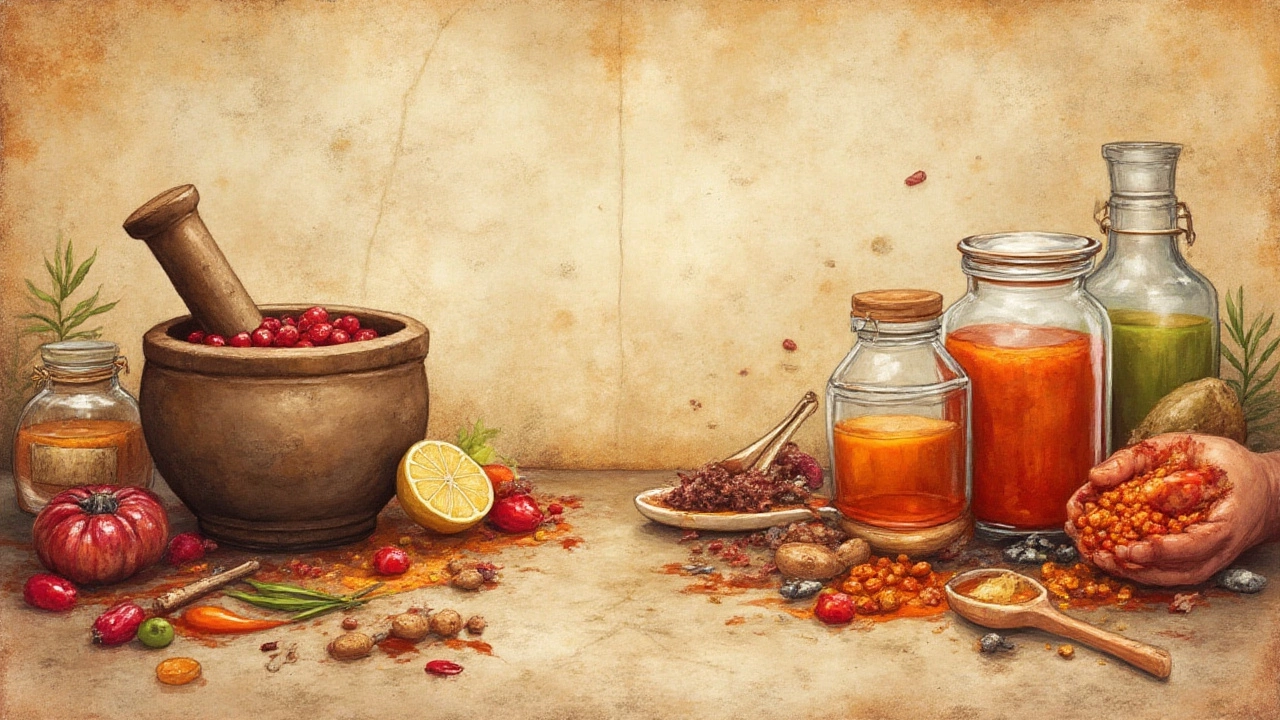Try pulling out a jar of chutney at a Kiwi barbecue and watch people’s reactions—curious, delighted, sometimes slightly skeptical. This little sidekick turns up everywhere, from the finest Indian spreads to fish and chip shops, but it’s more than just a condiment. Chutney is like a secret handshake between cuisines, instantly changing how a meal feels, smells, and tastes. There’s a reason nearly every culture has its own twist on this versatile wonder, and the story stretches far beyond just adding a ‘bit of flavour.’ Unpacking the purpose of chutney untangles more than just what you dip your samosa into—it’s about how we balance, elevate, and even fix food, day after day.
Where Chutney Comes From: History With a Tang
The earliest chutney dates back at least to ancient India, centuries before refrigeration, when cooks needed clever ways to make fruits and veg last longer. Preserved with spices, vinegar, or salt, chutneys kept root veggies safe to eat well into the off-seasons. Over time, the British swooped into India and brought chutney culture back to the UK (think Major Grey’s mango variant). Suddenly, chutney wasn’t just local fare: it was dancing onto scones and meat pies, and trekking across oceans.
What started as rural Indian kitchens using pestle and mortar soon morphed into a full-blown international love affair. Indian chutneys—usually made fresh from herbs, green mango, mint, or coconut—offer a mind-blowing play of sweet, spicy, and tart. The British and Kiwis leaned towards slow-cooked, sticky, chunky chutneys laced with brown sugar—think tamarillo or feijoa versions you find at Wellington cafes all winter.
The reach is truly global. Indonesian sambal, Caribbean pepper sauce, South African blatjang—all are technically chutneys (even if locals would shake their heads at being lumped together). A quick peek in a Wellington supermarket shows jars stacked next to mustards and relishes: tomato, date, kasundi, apricot, even kiwifruit. What ties them all together? Chutney is about preservation, invention, and—most of all—finding flavour where you least expect it.
The Real Purpose: Why Chutney Is A Game Changer
Let’s get straight to the big question: what’s the actual point of chutney? It’s not just about adding heat or sweetness. Chutney exists to do what lemon wedges do for fish, except a thousand times louder. Its job is to wake the palate up, fix blandness, cut through greasy or rich food, and bring dishes into balance.
If your dinner feels heavy (say, a curry loaded with ghee, or a cheesy sandwich), a tangy or spicy chutney brings everything back to life. That’s why mint chutney sits next to bhajis in Indian restaurants, and why tamarillo chutney saves cold meat sandwiches from five-day-old boredom. It’s a hack—a quick-fire fix for flavour flatness.
There’s another angle too. Chutneys aren’t just an accessory—they’re a way to use leftovers and avoid waste. Got extra green tomatoes in the garden? There’s a chutney for that. Too many tamarillos? Same. People even make chutney with overripe bananas.
But here’s the shocker: some studies suggest including sour foods like chutney can boost digestion. Spices like ginger and cumin can stimulate saliva, and acids help the gut break down rich dishes. So, when you see Indian thali plates with tiny dollops of chutney, it’s not just for looks. There’s a functional reason behind the dollop.
The Many Avatars: Types and Regional Twists
If you ask ten people what chutney is, you get ten different answers. In South India, ‘chutney’ might mean a quick blend of coconut, herbs, and chilli. It’s fresh, not cooked, and goes with dosa and idli. In Britain or New Zealand, the word usually signals a sweet, slow-cooked preserve in a jar.
The sheer number of chutney varieties is dizzying. Here’s a taste of the global spectrum:
- Indian Chutneys: Tomato, coriander, mango, mint, coconut—served fresh, tart, and spicy, all within minutes of making.
- British-Style Chutneys: Brown, syrupy, chunky mixes from plums, apples, or dates, mellowed with malt vinegar—usually matured for months in jars.
- Caribbean Chutneys: Sharp, often with hot peppers and tropical fruit like pineapple or papaya.
- African Chutneys: Feature strong hits of heat and sourness—blatjang in South Africa is made with dried fruit, sugar, and vinegar.
- Modern Hybrids: Kiwifruit chutney with chilli, tamarillo with five-spice, tomato and feijoa mashups tailored for local produce.
Usually, traditional chutneys are made and eaten fresh; the jarred kind (what most Kiwis call ‘chutney’) is meant to last for months. Here’s a quick look at just how diverse it gets:
| Type | Main Ingredients | Typical Accompaniment |
|---|---|---|
| Coriander-Mint Chutney | Coriander, mint, chilli, lemon | Samosas, kebabs, breads |
| Mango Chutney | Mango, sugar, vinegar, ginger | Curries, cheese, grilled meats |
| Tamarillo Chutney | Tamarillo, apples, onions, spices | Cold meats, sandwiches |
| Kiwifruit Chutney | Kiwifruit, onion, chilli, ginger | Burgers, grilled chicken |
| Blatjang | Dried fruit, vinegar, sugar, chilli | Barbecued meats, stews |
The point? There’s no single ‘right’ chutney. Go with what the meal (or the fridge) offers.
How To Use Chutney: Tips From A Chutney Obsessed Kitchen
If your chutney use never goes past a teaspoon with samosas, it’s time to get wild. Chutney’s talents come alive when you let it sneak its way into unlikely places.
- Sandwiches and Toasties: Spread it with cheese for instant zing. Try tomato chutney on toasty with brie. Or go classic with cheese, ham, and a thick swipe of apple chutney.
- Breakfast: Stir a dollop into scrambled eggs or on top of hash browns. Feijoa chutney with avocado toast? Total game-changer.
- Charcuterie Boards: Chutney outshines mustard when it comes to balancing smoked meats and sharp cheeses. Ditch the honey for a blob of mango chutney next time.
- Glazes and Marinades: Use chutney as the base for a roast glaze. Mix with a splash of soy and balsamic, brush it over roast chicken, and you’re sorted.
- Salad Dressings: Thin chutney with lemon juice and olive oil for a quick vinaigrette that packs more punch than bottled stuff.
- Quick Noodle Sauce: Mix chutney, soy sauce, and sesame oil for an instant noodle makeover. Try this with leftover veg for a shortcut stir-fry.
- Baked Brie With Chutney: Place a spoonful over cheese before baking. Serve with crackers if you want to win friends fast.
And of course, the best way—serve with simple curries, roast meats, or any dish that needs a rescue from blandness. If you’re making chutney at home, here are a few practical secrets for beginners: don’t skimp on vinegar or sugar (these are your preservation bodyguards), always cook down until thick, and sterilise your jars. Homemade chutney can last six months to a year if you nail these basics.

Chutney in Modern Life: Survivors, Innovators, and Future Stars
It’s easy to write off chutney as ‘just another condiment,’ but that’s missing the bigger picture. In New Zealand (and honestly, in most busy kitchens anywhere), chutney is the secret weapon for meal planning, lunchbox upgrades, and no-waste cooking.
Urban families love small-batch, artisanal chutneys because they turn staples into something way more exciting. Office workers slather it on wraps, while home cooks use jars of chutney as shortcuts for midweek dinners. “Chutney challenges” are a real thing on Instagram—people showing off the weirdest combination they dared to try (peach and habanero, beetroot and ginger, or even pineapple with black pepper). The bonus? Chutney is often naturally gluten-free and vegan-friendly, making it a crowd-pleaser for gatherings where everyone eats differently.
If you’re adventurous, make your own. Chutney recipes online are basically endless. Try swapping apple for pear in a classic recipe, or use native bush ingredients like kawakawa or horopito if you’re feeling patriotic. Leftover chutney? Gift it, swap it, or use it as barter. There’s something satisfying about handing over a little jar that you whipped up yourself—it feels like bottling summer!
To sum up, maybe chutney’s real purpose is this: it sneaks complexity into everyday life, using what you’ve got on hand, and making sure nothing ever tastes boring again. Think of it as the wildcard of your food lineup—always ready to surprise, always up for more.
